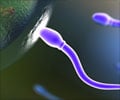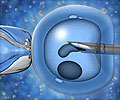Uncovering how adult cells revert back into a primordial, stem cell state is one of the key steps in bringing to fruition the promise of stem cell therapy.
Uncovering how adult cells revert back into a primordial, stem cell state is one of the key steps in bringing to fruition the promise of stem cell therapy.
Now, cell scientists at the Johns Hopkins University School of Medicine have identified key molecular players responsible for this reversion in fruit fly sperm cells. Reporting online this week in Cell Stem Cell, researchers show that two proteins are responsible redirecting cells on the way to becoming sperm back to stem cells."We knew from our previous work that cells destined to be sperm could revert back to being stem cells, but we didn't know how," says Erika Matunis, Ph.D., an associate professor of cell biology at the Johns Hopkins University School of Medicine. "Since, dedifferentiation is an interesting phenomenon probably occurring in a lot of different stem cell populations, we wanted to know more about the process."
Like all stem cells, each of the nine stem cells in the fly testis divides to form two daughter cells: One stays a stem cell and the other differentiates into an adult cell, in this case, a sperm cell. To figure out what might cause sperm cells to revert or dedifferentiate, Matunis's research team genetically altered the flies so that both cells become sperm, reducing the stem cell population in the testis to nothing.
About a week later, the team examined these fly testes and found that the stem cells had been repopulated.
To figure out how this was happening, the researchers first suspected two proteins—Jak and STAT—known to act together to help stem cells maintain their stem cell-ness. The team genetically altered flies to reduce the activity of Jak and STAT in the testis. Counting the number of cells, they found that the loss of Jak-STAT caused fewer cells to revert to stem cells; only 60 percent of testes regained stem cells compared to 97 percent in normal Jak-STAT-containing testes.
"We now know that in the fly testis, interfering with Jak-STAT signaling interferes with the process of dedifferentiation," says Matunis.
Next, Matunis would like to figure out how Jak and STAT control dedifferentiation. "We don't know if a cell is just reversing all of the steps to go back to being a stem cell or if it is doing something totally new and different, but we're eager to find out," she says.
Source-Eurekalert
RAS















